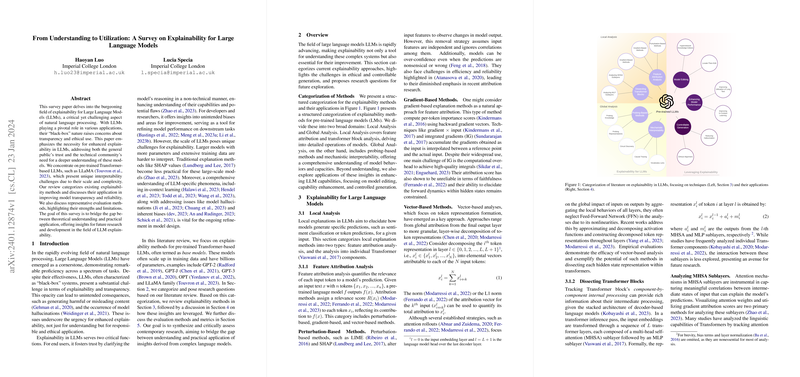Introduction
In the domain of NLP, LLMs stand at the forefront of current technological advancements, distinguished by their impressive array of capabilities. This surge in effectiveness is met with inherent complexities—most notably, the opaque nature of these models, which impede the transparency necessary for trust and ethical application. Recognizing these challenges, this paper expounds on explainability within the context of Transformer-based pre-trained LLMs.
Explainability Methods for LLMs
The classification of methods for discerning model reasoning is an essential facet of this paper. These have been compartmentalized into Local and Global Analysis strategies. Local Analysis pinpoints the specific inputs, such as tokens, that influence the model's outcomes, exploring techniques like feature attribution analysis. On the global scale, methods such as probes endeavor to understand the broader linguistic knowledge encapsulated within a model's architecture.
The role of attention mechanisms, particularly multi-head self-attention (MHSA) and feed-forward neural networks (FFN), is scrutinized for a more profound comprehension of the intermediate processes. Attention distribution, gradient attribution, and vocabulary projections are some of the mechanisms under investigation. These approaches enable dissection of the complexities within Transformer blocks to extract insights about LLM operations.
Applications of Explainability
Beyond theoretical understanding, explainability intersects with practical applications, aiming to refine LLMs in terms of functionality and ethical alignment. Incorporating explainability insights into model editing facilitates precise modifications without compromising overall performance on unrelated tasks. Additionally, leveraging these insights can optimize model capacity, especially in processing extended text lengths and In-Context Learning. Furthermore, explainability stands as a pillar in the development of responsible AI, providing pathways for reducing hallucinations and aligning ethical outcomes with human values.
Evaluation and Future Directions
An assessment of explanation plausibility and the aftermath of model editing is paramount for gauging the effectiveness of attribution methods. Datasets like ZsRE and CounterFact emerge as valuable assets for evaluating factual editing. To appraise truthfulness, the TruthfulQA benchmark becomes instrumental, with a focus on both the veracity and informativeness of output.
The future trajectory involves crafting explainability methods that resonate with various model frameworks and harnessing said explainability to facilitate the construction of trustworthy and human-value aligned LLMs. As these models evolve, clarity and fairness will become increasingly pivotal in harnessing their full potential for benefit, positioning explainability not as an option but as a cornerstone of LLM development and deployment.
